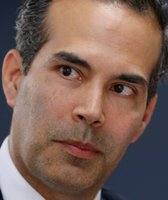To U.S. Rep. Chip Roy, Austin leaders' decision to cut police funding and reduce the size of the city's police force has led to skyrocketing homicides this year.
The City Council voted last summer to cut $21.5 million from the police budget and shift another $128 million from the Police Department to other city departments. The effect has been a cancellation of a cadet class and the dissolution of some law enforcement units.
In a June 3 interview with the Daily Signal, a conservative news site published by the Heritage Foundation, the Texas Republican argued that these changes have led to "a doubling of murder" that has been harmful to the city’s Black and Latino communities.
Instead, cities should be increasing their law enforcement presence at the ground level to ensure that officers build relationships in their communities, he argued.
"Why are we going the other way?" Roy said. "(Austin leaders say) 'Oh, let's reimagine police by getting rid of them.' What do you have? You have a doubling of murder in Austin, Texas. It's insane."
"That's not good for the communities that are allegedly being helped," Roy said.
The City Council’s decision to cut its police budget following massive protests in the wake of George Floyd’s death has already drawn scorn from the state’s Republican leaders. Lt. Gov. Dan Patrick, for instance, said that the cuts made Austin "one of the most dangerous cities in America and definitely in Texas." We rated that claim Pants on Fire.
More than 20 major U.S. cities slashed police budgets in the aftermath of 2020’s nationwide protests against police brutality. Austin’s cuts, which amounted to about one-third of its police department’s 2020 budget, were the largest in the nation.
It’s now been eight months since Austin’s police budget cuts went into effect. Have murders in the city doubled since then?
Have murders doubled in 2021?
It’s not entirely clear what Roy is comparing this year’s homicide numbers to. His office didn’t provide answers to several questions. But since he tied the cause of the rise to police budget cuts, we can infer he’s comparing this year’s levels to the year prior — before and after the cuts took effect.
We found that homicides so far this year are close to doubling the number recorded this time last year. According to monthly crime stats posted by the Austin Police Department, the city has recorded 33 murders from January through the end of May. Last year the city recorded 19 murders in the same five-month span. That’s a 74% increase.
But this increase paints a far more dramatic picture than the reality on the ground, experts say. Using a percentage increase to compare small numbers can give the impression of dramatic changes.
For instance, the city of El Paso recorded two homicides in the first quarter of 2020 and five homicides in the first quarter of 2021 — a 150% increase.
By comparison, the city of Houston recorded 16 more murders in the first quarter of 2021 than the first quarter of 2020. But because Houston’s total homicides is a much larger number, 94 in the first quarter of 2021, the 16 additional murders results in a much smaller percentage increase — 20%.
Gov. Greg Abbott also has used percentage increase figures to emphasize Austin’s crime numbers in his criticisms of police defunding. We rated that claim Half True.
"I’ve always been told: don’t use percentages for numbers that are under 50. If you’re looking at 30 or 45, don’t use a percentage difference because the percentage changes are so big," St. Edward's University criminologist Carsten Andresen said last year.
Because Austin’s homicide totals are low figures, comparing the homicide increase in that way isn’t seen by criminologists as an appropriate characterization.
Is the heightened murder rate tied to police budget cuts?
Any way you measure it, Austin homicide levels are elevated so far this year. But are these numbers high because of the Police Department’s budget cuts?
"It’s fair to say that violent crime has increased in Austin — and everywhere else," said Texas State criminologist Sean Roche.
According to a report released by the Major Cities Chiefs Association, which combines crime data of 63 metropolitan areas across the U.S., homicides are up by 30% in the first quarter of 2021 compared to the first quarter of 2020.
In many cities, homicides upticks have occurred despite increases in police funding since last year. Houston increased Police Department funding by adding $20 million to its nearly $1 billion budget, yet saw a 20% increase in murders in the first quarter of the year. Both Dallas and Fort Worth also increased law enforcement funding while recording upticks in homicides in the first quarter of this year.
Experts say it’s hard, if not impossible, to draw a direct correlation between fluctuations in police funding and crime rates when so many sociological factors are at play, the ongoing pandemic not least among them.
"Say the police are pulling back a little bit. Does that really affect how individual people decide whether to commit murder? We know that a lot of violence is in the moment — it's not a cold-blooded decision," Roche said. "Are a lot of people really going, 'normally I wouldn't try to shoot or knife this person, but I've heard that the police are defunding, so I've decided that murder is the right decision'?"
What is behind increased violent crime rates in Austin and across the nation? Crime trends often are influenced by macro-level drivers, especially during a pandemic. A cocktail of increased unemployment, the gun-buying surge, increased alcohol consumption and drug use can all combine to drive crime rates up. Unmeasurable factors, like civil unrest and political stress, also are in the mix.
All of these factors combined to make 2020 a year of high crime, and many of those factors are still present, Roche said. It’s unclear how or if those crime trends will abate as increased vaccination causes the pandemic to recede.
Our ruling
Roy said in an interview that police spending cuts in Austin is harmful to Black and brown communities because it has led to "a doubling of murder" in the city.
The city recorded 19 murders in the first five months of 2020, and 33 murders in the same five-month span of 2021, which is a 74% increase.
However, experts say that because these crime totals are low numbers, using percent change comparisons can easily mischaracterize or distort increases.
Roy also connects elevated crime levels to the Police Department’s reduced budget. But it’s difficult to draw a direct causal relation between police budget changes and crime stats, and Roy doesn’t provide any evidence.
Crime rates are responsive to a number of sociological factors, and those factors are driving homicide increases in cities across the country — regardless of any increase or decrease in police department funding, experts say.
We rate this claim Half True.
![PD stand guard as Austin Fire Department put out a car fire under Interstate 35 freeway in Austin Texas. Demonstrators protest over the police killing of George Floyd Saturday, May 30, 2020.[RICARDO B. BRAZZIELL/AMERICAN-STATESMAN]](https://static.politifact.com/CACHE/images/politifact/photos/RBB_BLM_selex___29322/ad173f6085a22b4fae9b9ed99af9aa1a.JPG)
















































